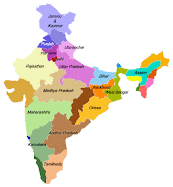I want to write much more about this trip, but it is so overwhelming to experience this place that it is difficult to come up with the words. Likewise, computers that don't stall every 5 minutes are hard to come by - or cyber shops that open before 10 a.m. or after 6 p.m. We're operating on some hard core IST.
***
After leaving Mcleod Ganj we took a car to Patankot and from there we took a bus to Amritsar (w/ AC!!!). Amritsar is the city that both of my parents are from. I had hoped to see their former homes, but it was not entirely possible. My mother's home was demolished a few years ago.
Before we left Austin, my Austin-ite cousin told me this: When we were small we used to go to your mom's house. At the time, we didn't know whose house we were going to, but we called it the Marble House because we used to play on the veranda, and set into the walls of the house there were rows of shining marbles.
I did see the ghost of my dad's childhood home. My cousin and his family live there, and they have renovated significantly. He told us that my grandparents originally owned the the house is on and the lot next door. So my grandparents and their 8 kids lived spread over this wide space. My grandparents sold one side of the house before they died. My cousin told me, if I understood his his son's broken-English translation, that the living room we were sitting in was once part of an open courtyard.
Chris and I stayed in a hotel that is about a 2-minute walk from the Golden Temple. I have always claimed that my first memory is from when I was 2-years old and in India with my mom. This is the memory: I am walking barefoot on the marble plaza that surrounds the temple and the water. I am holding her hand and watching the water when a fish leaps out and into the air. I get excited and tug at my mom's clothes.
I can remember what I saw, but also what I felt like in that moment. Yet, as an adult, I have often wondered if I invented the memory.
When we went to the Golden Temple (which deserves its own entry) on the night we arrived in Amritsar, I was astounded to see it sit upon the water like a brilliant jewel. We walked to the water and sat beside it, and immediately, about 15 koi fish swam where we sat. The next morning, we arrived again at 4:30 a.m., and a fish lept out of the water before my eyes. I felt certain then that I have not invented my earliest childhood memory.
Later in the day, my cousin's son drove us by my dad's college, Khalsa College - a stunning 300-year-old building, and then on to watch the bravado of the Pakistan-India border closing ceremony. I'll say this, it was the hottest we have been, and Indians can turn anything (in any weather) into a dance party. Pakistanis, not so much.
That night, my cousin took us all to dinner and then to what he claimed is the oldest kulfee shop in Amritsar. He said it's famous for a dish of kulfee topped with sweet, cold spagetti-like noodles. It was near Gandhi Gate, and my dad new right away which place I was speaking of when I described it on the phone, so I'll take my cousin's word that it is the oldest shop and the dish is famous. We at the cardamom flavored kulfee and noodles. We relished it This is the term Indian most use for enjoyment. "Will you relish it?" they ask us.
Finally, my cousin and his son drove Chris and me to our hotel on the backs of their motorcycles. This was a first for us - a motorbike ride on the whizzing, chaotic streets of Amritsar at night. I was first terrified and then elated. An exciting end to our stay in Amritsar.





